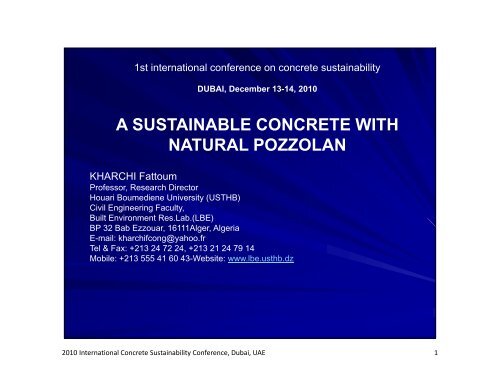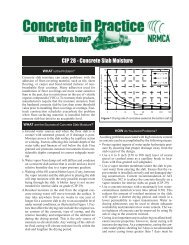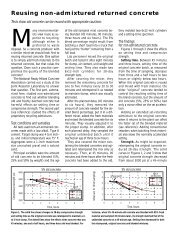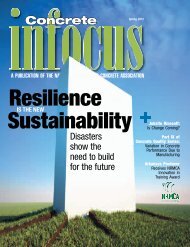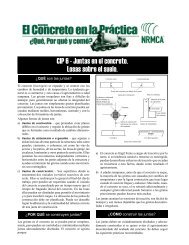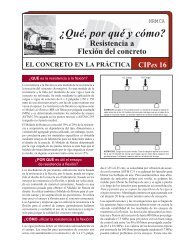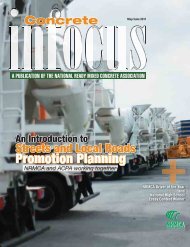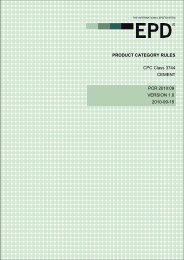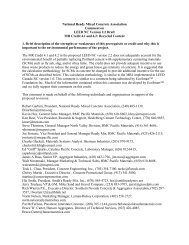Presentation - International Concrete Sustainability Conference
Presentation - International Concrete Sustainability Conference
Presentation - International Concrete Sustainability Conference
Create successful ePaper yourself
Turn your PDF publications into a flip-book with our unique Google optimized e-Paper software.
1st international conference on concrete sustainability<br />
DUBAI, December 13-14, 2010<br />
A SUSTAINABLE CONCRETE WITH<br />
NATURAL POZZOLAN<br />
KHARCHI Fattoum<br />
Professor, Research Director<br />
Houari Boumediene University (USTHB)<br />
Civil Engineering Faculty,<br />
Built Environment Res.Lab.(LBE)<br />
BP 32 Bab Ezzouar, 16111Alger, Algeria<br />
E-mail: kharchifcong@yahoo.fr<br />
Tel & Fax: +213 24 72 24, +213 21 24 79 14<br />
Mobile: +213 555 41 60 43-Website: www.lbe.usthb.dz<br />
2010 <strong>International</strong> <strong>Concrete</strong> <strong>Sustainability</strong> <strong>Conference</strong>, Dubai, UAE 1
Deterioration of the concrete<br />
Physical<br />
Chimical<br />
Structural loading<br />
Thermal shock<br />
Swelling<br />
Shrinkage<br />
Abrasion<br />
Leaching …<br />
Carbonation<br />
Alkali li - aggregate<br />
Ions chlorine Attack<br />
sulfatic Attack ...<br />
Expansion, Cracking, Alteration<br />
2010 <strong>International</strong> <strong>Concrete</strong> <strong>Sustainability</strong> <strong>Conference</strong>, Dubai, UAE 2
Solutions: Supplementary cement<br />
materials: SF, FAsh …..<br />
Algeria: exist: laitier (washes of<br />
siderurgique gq industry) and natural<br />
pozzolan,<br />
2010 <strong>International</strong> <strong>Concrete</strong> <strong>Sustainability</strong> <strong>Conference</strong>, Dubai, UAE 3
Effect of natural pozzolan on concrete<br />
resistance to sulfate attacks.<br />
Pozzolan is from the region of BENI SAF<br />
in the west of Algeria.<br />
The conference is organized in two parts<br />
1- Attacks mechanisms + effects on durability in<br />
general.<br />
2- Experimental program and results<br />
2010 <strong>International</strong> <strong>Concrete</strong> <strong>Sustainability</strong> <strong>Conference</strong>, Dubai, UAE 4
Sulfate attack is a chemical aggression.<br />
Water presence<br />
Permeability concrete<br />
Sulfate ions SO 4 is associated to different<br />
cations depending of environment (soil,<br />
sea water…etc)<br />
2010 <strong>International</strong> <strong>Concrete</strong> <strong>Sustainability</strong> <strong>Conference</strong>, Dubai, UAE 5
• SOILS gypsum (sulphate<br />
de calcium).<br />
gypsum not very soluble in water -------- slow attack<br />
• SEA WATER SEA, UNDERGROUND WATER<br />
Sulfates de magnesium (MgSO4)<br />
• ----------- the most agressive because very soluble in<br />
water , also (K2SO4 - Na2SO4).<br />
• AGRICULTURAL SOILS<br />
ammonium sulfates (NH4)2SO4<br />
also K2SO4, MgSO4)<br />
• CANALISATIONS: H 2 S (gas) react with aerial bacteria and<br />
product sulphates ion SO 4<br />
2010 <strong>International</strong> <strong>Concrete</strong> <strong>Sustainability</strong> <strong>Conference</strong>, Dubai, UAE 6
sulphates attacks<br />
Internal<br />
External<br />
Gypseous or sulfurous Granulats<br />
Addition of gypsum to clinker<br />
Hydration reaction energy in massive<br />
concrete<br />
soils<br />
Under ground water and sea water<br />
Industrial pollution<br />
Bacteriological transformation<br />
Destructive expansion<br />
2010 <strong>International</strong> <strong>Concrete</strong> <strong>Sustainability</strong> <strong>Conference</strong>, Dubai, UAE 7
sulfates Attack<br />
Characteristics of the concrete<br />
Environement<br />
Process of assessment of the aggression<br />
Transfer of the ions sulphate<br />
Chemical reactions between the<br />
controlled by the permeability and<br />
components of the cement and the<br />
diffusity of the material.<br />
SO<br />
2 -<br />
4 ions<br />
Expansion phenomenon<br />
Apparition of new crystalline phases<br />
2010 <strong>International</strong> <strong>Concrete</strong> <strong>Sustainability</strong> <strong>Conference</strong>, Dubai, UAE 8
Schematic presentation of the attack to the sulphates<br />
Water<br />
Sulphate<br />
Environement<br />
External<br />
EAS<br />
High<br />
Permeability<br />
Pores, capillary<br />
High E/C, mauvaise cure<br />
Microcracking<br />
(structural loading,heat<br />
and cold, drying and<br />
watering cycles )<br />
AES : External Attack Sulphate<br />
2010 <strong>International</strong> <strong>Concrete</strong> <strong>Sustainability</strong> <strong>Conference</strong>, Dubai, UAE 9
Chemical interactions<br />
I) Secondary gypsum formation<br />
Ionic substitution between the portlandite and the sulphates<br />
case of the sulphate of Na 2 SO 4 sodium<br />
Ca (OH) 2 + Na 2 SO 4<br />
+2H 2 O CaSO 4 .2H 2 O + 2NaOH<br />
(Secondary gypsum , expansion)<br />
II) Secondary ettringite it formation<br />
Starting from the residual anhydrous C3A<br />
C 3 A + 3CaSO 4 .2H 2 O +26H 2 O C 3 A.3CaSO 4 .32H 2 O<br />
(Ettringite, expansion)<br />
from hydrated aluminates (Monosulfoaluminates)<br />
C 3 A.Ca (OH) 2 .xH 2 O + 2Ca(OH) 2 +3SO 4 + 11H 2 O C 3 A.3CaSO 4 .32H 2 O<br />
(Ettringite, expansion)<br />
2010 <strong>International</strong> <strong>Concrete</strong> <strong>Sustainability</strong> <strong>Conference</strong>, Dubai, UAE 10
Case of the magnesium sulphate MgSO 4<br />
1.Formation of expansive product<br />
Ca (OH) 2 + MgSO 4 CaSO 4 + Mg(OH) 2 (Brucite, weak solubility )<br />
C 3 A+3CaSO 4 .2H 2 O +26H 2 O C 3 A3CaSO A.3CaSO 4 .32H 2 O(Ettringite (Ettringite, expansion)<br />
Substitution of the Ca2+s ions by the Mg2+s ions in the C-S-H<br />
C-S-H + MgSO 4 CaSO 4 .2H 2 O+ (C , M)-S-H (weakly cohesive )<br />
Consequences are an expansion et cracking due to secondary ettringite and a resistance<br />
loss due to the consumption of CSH. The silicate of hydrated magnesium (Mg-S-H)<br />
formed doesn't have any binding properties, and therefore the hydrated becomes soft and<br />
disjointed<br />
2010 <strong>International</strong> <strong>Concrete</strong> <strong>Sustainability</strong> <strong>Conference</strong>, Dubai, UAE 11
Primary ettringite = formed in begining cement hydration .<br />
Not nocive but indispensable to regulate cement prise.<br />
Secondary ettringite =Expansive,<br />
- molarvolumeisto3à8higher than primary ettringite<br />
molar volume.<br />
- crystallize in hard concrete<br />
2010 <strong>International</strong> <strong>Concrete</strong> <strong>Sustainability</strong> <strong>Conference</strong>, Dubai, UAE 12
Experimental<br />
programm<br />
2010 <strong>International</strong> <strong>Concrete</strong> <strong>Sustainability</strong> <strong>Conference</strong>, Dubai, UAE 13
The study was conducted on three types<br />
of concrete: an ordinary concrete BO, , a<br />
high performance concretes BHP (with<br />
superplastizer) and a concrete with<br />
pozzolan BHPZ. . Following parameters<br />
were studied:<br />
d<br />
Expansion, shrinkage, chloride<br />
penetration and strength, of concrete<br />
specimens immersed in the solution<br />
containing 5% NH4SO4 ammonium<br />
sulphate.<br />
2010 <strong>International</strong> <strong>Concrete</strong> <strong>Sustainability</strong> <strong>Conference</strong>, Dubai, UAE 14
MATERIALS<br />
Cement : CEMII/A 42.5<br />
Surface spécifique ….3400-3650 cm 2 /g<br />
CaO SiO 2<br />
Al 2<br />
O<br />
3<br />
Chemical composition<br />
FeO 3<br />
MgO RI SO 3<br />
PAF<br />
minéralogy<br />
Composition<br />
Na 2O K 2<br />
O CaOl C 3<br />
S ßC 2<br />
S C 3<br />
A<br />
24.3<br />
59.8 16.9<br />
11.6<br />
60.88<br />
5.56 3.83 1.08 3.30 0.27 2.37 0.23 0.48 0.71<br />
6.56<br />
5 3 4 4<br />
Tab1: Chemical and minéralogy composition of the cement<br />
C 4<br />
A<br />
F<br />
Sand : Rolled siliceous sand of 3,5 mm maximum aggregate size.<br />
Density = 2, 60<br />
Aggregates : class 3/8 and 8/16 of silico-chaky chaky origin (carrer)<br />
Density = 2, 50<br />
2010 <strong>International</strong> <strong>Concrete</strong> <strong>Sustainability</strong> <strong>Conference</strong>, Dubai, UAE 15
I.4) Natural pozzolan of volcanic origin.<br />
Density = 2, 65<br />
Specific surface = 9500 cm 2 /g<br />
L’indice d’activité de la pouzzolane utilisée a été déterminé selon<br />
la norme EN 450<br />
i = Rc (MZ25) / Rc (MZ0) = 0.82<br />
la pouzzolane étudiée est donc réactive<br />
Elément<br />
s<br />
SiO 2<br />
Al 2<br />
O 3<br />
Fe 2<br />
O<br />
3<br />
CaO MgO SO 3<br />
K 2<br />
O Na 2<br />
O P.A.F R.I<br />
% 44,95 16,91 9,47 14,59 3,76 0,20 1,35 1,34 4,30 0,56<br />
Tab2: Chemical composition of the pozzolan<br />
2010 <strong>International</strong> <strong>Concrete</strong> <strong>Sustainability</strong> <strong>Conference</strong>, Dubai, UAE 16
Figure 4 : R.X.D analysis of pozzolan<br />
R X D results revealed the predominance of feldspars and<br />
pyroxene and a small amount of hematite and clay.<br />
Important quantity of portlandite developed during<br />
the cement hydration in concrete<br />
Pozzolanic reaction continuous by consumption of the portlandite<br />
liberated during the cement hydration in concrete<br />
2010 <strong>International</strong> <strong>Concrete</strong> <strong>Sustainability</strong> <strong>Conference</strong>, Dubai, UAE 17
I.5) Reducing superplasticizer of water<br />
Superplasticiser : a local production, a high reducing water superplasticizer of the 3rd<br />
generation derived from polycarboxylates. the manufacturer’s use recommendations is 0, 5 to<br />
2% of the cement weight<br />
2010 <strong>International</strong> <strong>Concrete</strong> <strong>Sustainability</strong> <strong>Conference</strong>, Dubai, UAE 18
II) Composition of the concretes<br />
Sand Gravel 3/8<br />
Gravel<br />
8/16<br />
Cement (C) Water (W) W/C<br />
763,5 137 837 425 212,5 0,5<br />
Tab5: Composition of the ordinary concrete in Kg /m3 (OC)<br />
Sand Gravel 3/8 Gravel 8/16 Cement C<br />
Water<br />
W<br />
W/C<br />
MF30<br />
763,5 137 837 425 107,66 0,3<br />
26,48 l<br />
28,33<br />
Kg<br />
Tab6: Composition of the HPC in Kg /m3 (HPC)<br />
2010 <strong>International</strong> <strong>Concrete</strong> <strong>Sustainability</strong> <strong>Conference</strong>, Dubai, UAE 19
Sand Gravel 3/8 Gravel 8/16 PZ 5% C W W/C MF30<br />
763,5 137 837 21,25 403,75 107,66 0,3<br />
26,48 (l)<br />
28,33 (Kg)<br />
Tab7: Composition of the HPC with addition of pozzolan in Kg /m3 (HPCZ)<br />
II.1) Specimen preparation, curing and testing<br />
After mixing the concrete, the specimens were kept in the moulds and covered for<br />
24 hours in the air laboratory. After demoulding, the specimens were subjected<br />
to28 days of curing in water at 23 ± 2°C before being subjected to sulphate solutions.<br />
The concrete specimens were immersed in 5 % NH4SO4 ammonium sulphate<br />
which was renewed every 30 days.<br />
2010 <strong>International</strong> <strong>Concrete</strong> <strong>Sustainability</strong> <strong>Conference</strong>, Dubai, UAE 20
II.2)Evolution of the mechanical resistances<br />
II.2.1)Compressive strength<br />
80<br />
Com mpression Strengh<br />
(MPa)<br />
60<br />
40<br />
20<br />
OC<br />
HPC<br />
HPCZ<br />
0<br />
1 2 3 4 5<br />
Age (days)<br />
Fig 13: Evolution of the compressive strength of different types of concrete in<br />
water<br />
80<br />
Compression Strengh<br />
(MPa)<br />
60<br />
40<br />
20<br />
OC<br />
HPC<br />
HPCZ<br />
0<br />
1 2 3 4 5<br />
Age (days)<br />
Fig 14: Evolution of the compressive strength of different types of concrete in<br />
sulphated solution<br />
2010 <strong>International</strong> <strong>Concrete</strong> <strong>Sustainability</strong> <strong>Conference</strong>, Dubai, UAE 21
II.2.3) Permeability to the chloride ions<br />
2010 <strong>International</strong> <strong>Concrete</strong> <strong>Sustainability</strong> <strong>Conference</strong>, Dubai, UAE 22
3500<br />
3000<br />
Charge<br />
(coulomb)<br />
2500<br />
2000<br />
BO<br />
BHP<br />
1500 BHPZ<br />
1000<br />
500<br />
0<br />
1 2 3 4<br />
Age (days)<br />
Charge passed in the concrete specimen kept in sulphate environment<br />
2010 <strong>International</strong> <strong>Concrete</strong> <strong>Sustainability</strong> <strong>Conference</strong>, Dubai, UAE 23
One can note that the compressive and tensile strength of the concretes with<br />
additions of pozzolan are all superior to the ordinary concretes and high performance<br />
concretes without addition.<br />
The permeability to the chloride ions of the concretes with addition of pozzolan is<br />
lower to the ordinary concretes and high performance concretes without addition.<br />
II.2.4) Expansion<br />
015 0,15<br />
OC HPC HPCZ<br />
Expansion (%)<br />
0,1<br />
0,05<br />
0<br />
0 30 60 90 120 150 180<br />
Immersion period (days)<br />
Fig 19: Expansion of different kinds of concrete in the sulphated solution<br />
2010 <strong>International</strong> <strong>Concrete</strong> <strong>Sustainability</strong> <strong>Conference</strong>, Dubai, UAE 24
The results show that the concretes undergo an expansion, nevertheless the<br />
one of the ordinary concrete is accentuated more that the one of the concretes<br />
with or without addition of pozzolan.<br />
The ordinary concrete with a W/C report = 0, 5, present a matrix very porous<br />
that facilitates the penetration of the solution charged of ions sulphate in its<br />
interior. These, in presence of aluminate anhydrous tricalcique of hydrates or of<br />
aluminized them hydrated react to form the secondary, chatty ettringite the<br />
expansion.<br />
2010 <strong>International</strong> <strong>Concrete</strong> <strong>Sustainability</strong> <strong>Conference</strong>, Dubai, UAE 25
BO HPC HPCZ<br />
II.2.5) Skrinkage<br />
Autogenous skrinka age (m/m)<br />
180<br />
160<br />
140<br />
120<br />
100<br />
80<br />
60<br />
40<br />
20<br />
0<br />
0<br />
15<br />
30<br />
45<br />
60<br />
75<br />
90<br />
105<br />
120<br />
135<br />
150<br />
165<br />
180<br />
Age (days)<br />
Fig 20: Autogenous skrinkage of different types of concrete<br />
300<br />
BO HPC HPCZ<br />
drying skrinka age (m/m)<br />
250<br />
200<br />
150<br />
100<br />
50<br />
0<br />
1<br />
3<br />
4<br />
6<br />
7<br />
9<br />
10<br />
12<br />
13<br />
15<br />
16<br />
18<br />
0<br />
5<br />
0<br />
5<br />
0<br />
5<br />
0<br />
5<br />
0<br />
5<br />
0<br />
5<br />
0<br />
Age (days)<br />
Fig 21: Drying skrinkage of different types of concrete<br />
2010 <strong>International</strong> <strong>Concrete</strong> <strong>Sustainability</strong> <strong>Conference</strong>, Dubai, UAE 26
BO HPC HPCZ<br />
450<br />
400<br />
Total skrinkage( (m/m)<br />
350<br />
300<br />
250<br />
200<br />
150<br />
100<br />
50<br />
0<br />
0<br />
15<br />
30<br />
45<br />
60<br />
75<br />
90<br />
105<br />
120<br />
135<br />
150<br />
165<br />
180<br />
Age (days)<br />
Fig 22: Total skrinkage of different kinds of concrete.<br />
The skrinkage high performance concretes that they are with or without addition and<br />
having an W/C report = 0,3 are weaker than the one of the ordinary concrete prepared<br />
with an W/C report = 0,5.<br />
The natural pozzolan used for the confection the high performances concrete with<br />
addition (HPCZ) acts by its very advanced fineness, its latent property and by its heat of<br />
hydration. The effect combined of these three parameters generates a sensitive<br />
increase of the skrinkage to the first ages. To means term, the supplementary CSH<br />
descended of the reaction pouzzolanique generate a reduction of the distortion due to<br />
the skrinkage. Indeed, the dense structure of the concretes due to the reduction of the<br />
measurements and percentage of the pores prevents the migration of the water.<br />
2010 <strong>International</strong> <strong>Concrete</strong> <strong>Sustainability</strong> <strong>Conference</strong>, Dubai, UAE 27
Conclusion<br />
.<br />
The addition of natural pozzolan in combination with an appropriate dosage of<br />
superplasticizer gave a high strength concrete(70 MPa). The experimental analysis of<br />
some aspect of sustainability showed thatt the concrete also has good performance with<br />
regard chlorides permeability and resistance to sulphates.<br />
2010 <strong>International</strong> <strong>Concrete</strong> <strong>Sustainability</strong> <strong>Conference</strong>, Dubai, UAE 28


